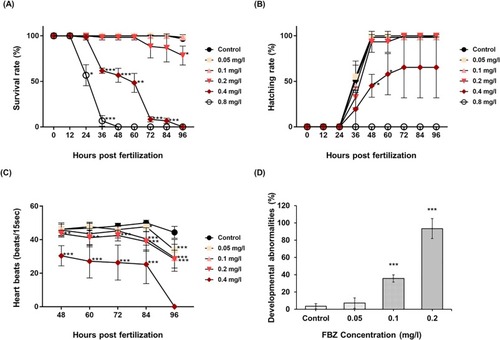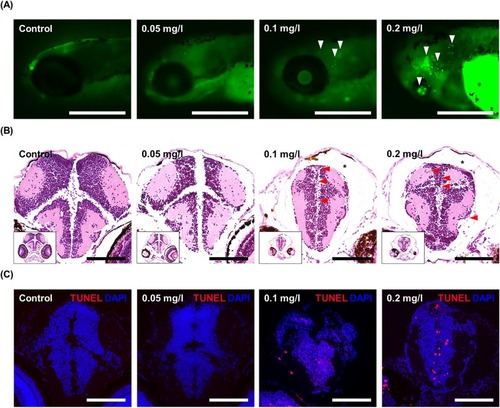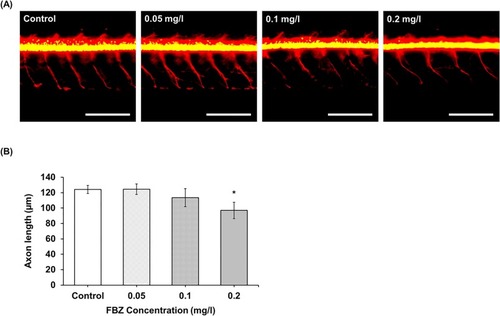- Title
-
Flubendazole exposure disrupts neural development and function of zebrafish embryos (Danio rerio)
- Authors
- Kim, J., Bang, J., Ryu, B., Kim, C.Y., Park, J.H.
- Source
- Full text @ Sci. Total Environ.
|
Toxic effects of Flubendazole (FBZ) in zebrafish embryo development. (A) Survival rates and (B) hatching rates of zebrafish embryos exposed to FBZ (control, 0.05, 0.1, 0.2, 0.4, and 0.8 mg/l) for 96 h post fertilization (hpf). n = 3 experiments, n = 20 embryos per experiments in each group. Data represent the mean ± SEM. (C) Heart beats per 15 s until 96 hpf (control, 0.05, 0.1, 0.2, and 0.4 mg/l). n = 10 embryos per group. Data represent the mean ± SD. (D) The percentage of abnormally developed zebrafish embryos at 96 hpf (control, 0.05, 0.1, and 0.2 mg/l); Pericardial edema, yolk sac edema, head and eye deformity, and axial malformation. n = 3 experiments, n = 20 embryos per experiments in each group. Data represent the mean ± SEM. *P < 0.05; **P < 0.01; ***P < 0.001. |
|
Morphological alterations related to developmental neurotoxicity induced by FBZ exposure. (A) The craniofacial structure of FBZ-treated zebrafish at 96 hpf. Scale bar = 350 μm. (B) Body length, head size and eye size of embryos. n = 10 embryos per group. Data represent the mean ± SD. *P < 0.05; **P < 0.01; ***P < 0.001. |
|
Apoptosis in zebrafish embryo induced by FBZ exposure until 96 hpf. (A) The acridine orange positive cells detected in the zebrafish brain region (white arrowhead). Scale bar = 400 μm. (B) Enlarged space between the skull and brain (asterisk) and pyknotic nuclei (red arrowhead) in histopathological analysis of zebrafish exposed to FBZ (0.1, and 0.2 mg/l). Scale bar = 100 μm. (C) TUNEL analysis of zebrafish brain exposed to control, 0.05, 0.1, and 0.2 mg/l of FBZ. Scale bar = 100 μm. |
|
Gene expression changes following FBZ exposure. The expression of (A) apoptosis-related genes (tumor protein p53 (p53), b-cell lymphoma 2 (bcl2), caspase 3 (casp3), caspase 8 (casp8), and caspase 9 (casp9)), (B) neurogenesis-related genes (sonic hedgehog a (Shha), neurogenin 1 (ngn1), neurod (nrd), and elav like neuron specific rna binding protein 3 (elavl3)), and (C) axon growth and neuronal maturation (glial fibrillary acidic protein (gfap), myelin basic protein (mbp), alpha 1 tubulin (α1-tubulin), growth associated protein 43 (gap43), and synapsin IIa (syn2a)). Data are quantified with standard curves using elongation factor 1-alpha (ef1α) and actin, beta 1 (β-actin) as a reference gene and normalized to control. Data represent the mean ± SD. *P < 0.05; **P < 0.01; ***P < 0.001. |
|
Axon structure of FBZ-treated transgenic zebrafish at 96 hpf. (A) RFP expressing spinal cord axon in Tg(olig2-dsRED) zebrafish are shown in control, 0.05, 0.1, and 0.2 mg/l FBZ. Scale bar = 150 μm. (B) Axon length of Tg(olig2-dsRED) zebrafish (μm). n = 3 embryos per group. Data represent the mean ± SD. *P < 0.05. |
|
(A) Representative heat map and waveform images of zebrafish multi-electrode array recording (control and 0.2 mg/l of FBZ). (B) Mean local field potential Rate (Hz), (C) burst frequency (Hz), (D) network burst frequency (Hz), and (E) synchrony index. n = 4 embryos per group. Data represent the mean ± SD. *P < 0.05; **P < 0.01; ***P < 0.001. |
|
|







